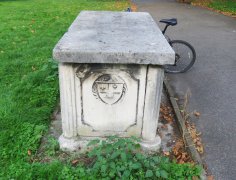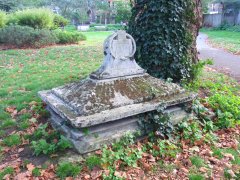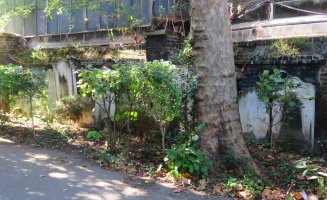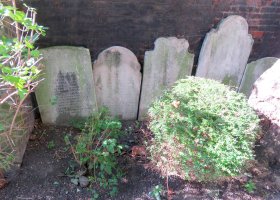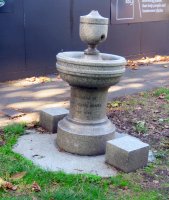St Andrew's Burial Ground Gardens, Grays Inn Rd
A former burial ground of a City Church, St Andrew’s Gardens retains some table tombs in situ, and some battered headstones along one side; there is also a Victorian drinking fountain. The poet Chatterton’s remains were reinterred here but there is no gravemarker.
Along Gray’s Inn Road is St Andrew’s Gardens, former burial ground of St Andrew’s Holborn: the Church itself stands about 10 minutes stroll away, going to the south end of Gray’s Inn Rd, and turning left along High Holborn. Being on a constrained site, St Andrew’s ran out of burial space, and this site was opened in 1754, fulfilling the function for almost a century before burials were halted in 1850. In 1885, permission was granted to convert the burial ground into a public garden.
Some number of large chest tombs are dotted around the Gardens (see picture at top of page, click to enlarge), mostly with inscriptions no longer readable, but including examples characteristic of both the 18th and 19th Centuries. We can see a fair sample of how such things are built: typically four corner pieces of stone, sometimes with a decorative treatment, side panels which may be solid stone or thin stone over a brick core, and a single great stone slab on top, which may be a harder sandstone or granite than the soft limestone underneath.
Tomb chests.
One interesting different example next to a large plane tree has a shallow plane “roof” on top, bearing a carved stone in the shape of a bell, with what at first glance are decayed rings through the top, but on closer examination appear to be decayed snakes swallowing their tales, rather a pagan symbol of life eternal, but quite common in 18th and very early 19th Century monuments.
The Gardens have been largely cleared of headstones, but, a fairly common practice, a number of these have been propped along an exterior wall, their state of preservation depending on the prevailing wind and how protected they happen to be by surrounding plants. Most of them are typical 19th Century pieces, some with cut tops and the odd minor decoration, but there are one or two which look 18th Century.
Headstones by the perimeter wall.
There was a daughter church of St Andrew’s erected in 1837 on the other side of the road, called Holy Trinity, to the design of the architect James Pennethorne, which became redundant in 1928, with the grounds sold off for redevelopment in 1931. The first incumbent of that church was the Revd. James William Worthington, and his wife Abigail Worthington, d.1855, was interred in the burial ground. More famously, the poet Thomas Chatterton, who died in 1770 and was buried in the Shoe Lane Workhouse Cemetery (which was a few houses down from St Andrew’s Holborn), had his bones apparently moved to St Andrew’s Burial Ground at some time after the workhouse closed at the end of the 1830s (the remains were said by a biographer to have instead been taken to St Mary Redcliff, Bristol, but this is unsupported and doubtful).
At one end of the Gardens is a Victorian fountain, a fairly standard circular one with an urn on top from which the water emitted into a basin below, made of Cornish granite, presented by Bessie Orbell (?) in 1888, as part of the original furnishings of the new Gardens, along with the surviving wrought iron entrance gates.
The 1888 drinking fountain.
The visitor may be left, perhaps, musing over how short a time people may be remembered even through supposedly ever-lasting stone memorials: a single generation before the graveyard is cleared, and the length of two lives for most of the inscriptions to wear away, and most of the memorials to be lost in their entirety. It would be relatively straight-forward to avoid such rapid erosion had a little thought gone into the repositioning of the memorial stones and where the wind channels arise.
Nearby to the north and west is another interesting former graveyard, St George's Gardens, Bloomsbury, or heading southwards to Little Italy, can be seen a sculptured plaque to the Italian Mazzini.

